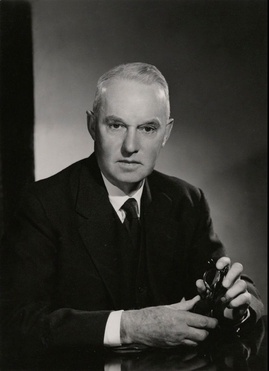Edmund Hirst facts for kids
Quick facts for kids
Edmund Hirst
|
|
|---|---|

Sir Edmund Langley Hirst, FRS
© National Portrait Gallery, London |
|
| Born |
Edmund Langley Hirst
21 July 1898 Preston, Lancashire, England
|
| Died | 29 October 1975 (aged 77) |
| Alma mater | University of St Andrews |
| Spouse(s) |
|
| Awards | Davy Medal (1948) Fellow of the Royal Society |
| Scientific career | |
| Institutions | University of Edinburgh |
Sir Edmund Langley Hirst (born July 21, 1898 – died October 29, 1975) was an important British chemist. He was known for his amazing work with sugars and other complex carbohydrates.
Contents
Life of a Chemist
Edmund Hirst was born in Preston, Lancashire, England. He grew up and went to school in different places, including Burnley and Ipswich. Later, he studied chemistry at the University of St Andrews in Scotland. He even received a special scholarship to help him with his studies.
World War I and Early Career
During World War I, Hirst was asked to join the army in 1917. However, he convinced the authorities to let him return to university. He used his chemistry skills to study mustard gas, a chemical weapon. After the war, he finished his studies and earned his PhD in 1921.
In 1923, Hirst started teaching at the University of Manchester. The next year, he moved to Newcastle-upon-Tyne. There, he worked with another famous chemist, Norman Haworth. Together, they made a huge breakthrough in 1934. They were the first to create Vitamin C in a lab! This was a very important discovery for health and science.
Moving to Edinburgh
In 1947, Hirst moved to Edinburgh, Scotland, to work at the University of Edinburgh. He quickly became a respected member of the scientific community. In 1948, he was chosen as a Fellow of the Royal Society of Edinburgh. This is a big honor for scientists. He later served as the vice president and then president of this society.
Hirst was in charge of the Organic Chemistry department at the University of Edinburgh. He led the department from 1959 to 1968. For his great contributions to science, he was made a knight in 1964. This meant he could use "Sir" before his name.
In 1968, he received another special honor, an Honorary Doctorate, from Heriot-Watt University. Edmund Hirst became unwell in 1973 and passed away in Edinburgh in 1975.
Amazing Discoveries in Chemistry
Sir Edmund Hirst was a very busy scientist. He published over 260 research papers! His work focused on understanding the structure of different types of sugars. These include simple sugars and more complex ones like those found in plants.
He and his team studied many natural substances. They looked at things like starches, gums, and other natural sugars found in plants and even seaweed. They also created new versions of important sugar molecules in the lab. Their discoveries greatly improved our understanding of how sugars work. This field of study is called carbohydrate chemistry.
Family Life
Sir Edmund Hirst was married twice. He first married Beda Winifred Phoebe Ramsay in 1925. Later, he married Kathleen (Kay) Jenny Harrison. He did not have any children from either marriage.

